Disney historian Jeff Kurtti penned this tribute to James MacArthur for us:
James MacArthur, Helen Hayes and Walt Disney

One of Walt Disney’s many talents was a flair for casting, and a genius for recognizing unusual talent. Although the application of this gift within the Animation trade is well-known, as is the roster of live-action stars who came to be associated with Walt, both professionally and culturally—Annette Funicello, Hayley Mills, Fess Parker, Fred Mac Murray, and Dean Jones to name a few—there is one actor whose relationship with Walt Disney is frequently forgotten: James MacArthur.
Upon the passing of the 72-year-old actor last week, obituaries inevitably led with MacArthur’s 11-year role on the popular TV series Hawaii Five-O. His film and television career, however, owes much of its momentum to his casting, at the suggestion of Walt himself, in a series of feature films early in his career.
MacArthur was born in Los Angeles in 1937, and was adopted in infancy by playwright Charles MacArthur and his wife, actress Helen Hayes. Although it would be easy to assume that James got a free pass into an acting career just for being the son of such a powerhouse show business couple, quite the opposite is the case. Instead, he received his training in summer stock, where he not only acted, but also worked as a set painter, lighting director—and even chief of the parking lot.
In 1955, at the age of 18, he was cast in a TV play (directed by John Frankenheimer) as a misunderstood teenager on the brink of delinquency. His performance was praised by critics, and when Frankenheimer directed the movie version of the play the following year (as The Young Stranger), MacArthur was again chosen for the starring role. Once again, his performance was critically acclaimed, and in the appreciative audience was Walt Disney.
Twentieth Century-Fox and other major studios were not unaware of young MacArthur, either, but it was Walt who won an exclusive contract with the young actor. “I had a loose picture deal contract with him,” MacArthur recalled, “whereby if he wanted to use me he did—but I had script approval.”
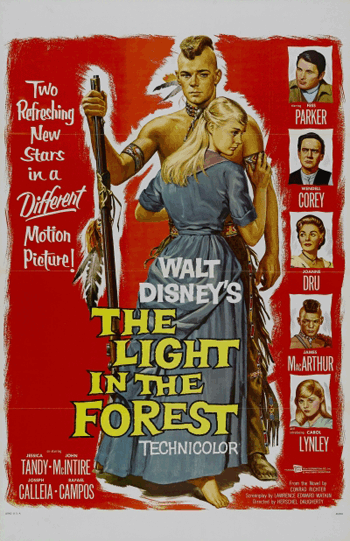 Walt had been looking for the better part of two years to find the right performer to play “True Son/Johnny Butler” in his adaptation of Conrad Richter’s thought-provoking novel, The Light in the Forest. The difficult role is that of a white boy who has been brought up by the Delaware Indians and faces prejudice and violence when he is returned to life among the whites.
Walt had been looking for the better part of two years to find the right performer to play “True Son/Johnny Butler” in his adaptation of Conrad Richter’s thought-provoking novel, The Light in the Forest. The difficult role is that of a white boy who has been brought up by the Delaware Indians and faces prejudice and violence when he is returned to life among the whites.
(For those who insist on the legend of homogenized simplicity in the stories Walt chose to adapt, this novel is nothing less than an allegory using the colonization of the American wilderness in the 1750s as an exemplar of U.S. domination of third world countries in the 1950s.)
The role required a rare combination of appealing naiveté and intelligent strength—and the performance of a precarious conversion between cultures, as well as from youth to adulthood. MacArthur performed the role with a confidence well beyond his teen status, and his professionalism impressed the rest of the esteemed cast, which included Fess Parker, Wendell Corey, Joanne Dru, Jessica Tandy, and Carol Lynley (in her feature film debut). Walt was likewise impressed, and gave MacArthur star billing.
MacArthur remained stoic about his own work on the film; instead, he immediately remembered the fun he had in the filmmaking. “When we were making The Light in the Forest,” the actor recalled, “Fess Parker gave me a lot of water-skiing pointers—and so whenever I want to relax, I go flying across the water.”
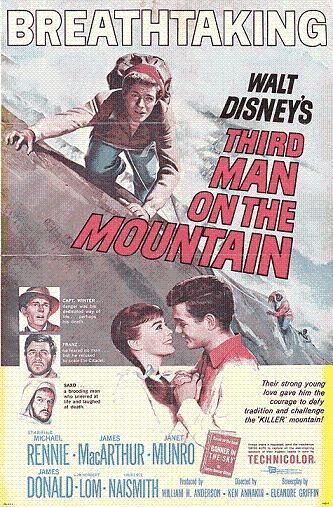 MacArthur had made The Light in the Forest over his summer break from Harvard University, where he was studying history, and the following year he embarked on his second Disney feature, Third Man on the Mountain, based upon James Ramsey Ullman’s 1955 Newbery Honor Book Banner in the Sky.
MacArthur had made The Light in the Forest over his summer break from Harvard University, where he was studying history, and the following year he embarked on his second Disney feature, Third Man on the Mountain, based upon James Ramsey Ullman’s 1955 Newbery Honor Book Banner in the Sky.
MacArthur played Rudi Matt, a young kitchen worker who is determined to conquer The Citadel—the looming, snowcapped peak that claimed his father’s life. Encouraged by both a famed English climber and the youth’s devoted girlfriend, Rudi endures a grueling training period before he is ready to face the dangers of the killer mountain.
Producer Bill Anderson had read the Ullman book, and simultaneously saw some impressive mountaineering film by French guide Gaston Rebuffat. Disney bought both climbing footage and the film rights to the book, and Walt suggested that Bill go to England and set up a unit to make the film.
The ambitious feature was made on location in Switzerland over several months, and involved meticulous authenticity and attention to detail. This was not a film that used photographic processes and camera trickery for its effect, much of the great richness of the film comes from the legitimacy of it locale and action. Director Ken Annakin recalled that the cast, including MacArthur (but excluding Herbert Lom), did most of their own climbing. In fact, the young actor went off with his guide on the first weekend of location shooting, and climbed the Matterhorn himself! “I only discovered it Monday morning,” the director recalled, “when we started to work again and he was absolutely shagged, and he admitted to me that he had climbed it.”
Walt visited the location for a few weeks during production, and Studio publicist Leonard Shannon recalled the boss strolling through the village of Zermatt, wearing a smart Tyrolean fedora, and simply standing and contemplating the majestic mountain. “He would stand and literally look at that thing for an hour or so,” Shannon remembered.
The finished film is one of the finest adventure dramas of its era. The show business daily Variety said “It has the sort of altitude thrills to send the viewer cowering deep in his seat and the sort of moving drama to put him on the edge of it.” Time magazine felt that the film might “well become a children’s classic of the screen, a sort of ‘Tom Sawyer of the Alps’.” But the film was a financial disappointment, and audiences were enthusiastic, but small.
In fact, film writer Karl Holzheimer succinctly stated, “Third Man on the Mountain may be the best Disney live-action feature that you’ve never seen.”
At this point, MacArthur gave up his studies to make acting his full time career. He dropped out of Harvard in his sophomore year, and began work on his next Disney film, an adaptation of the Robert Louis Stevenson novel Kidnapped.
MacArthur plays the virtuous David Balfour, a sturdy young man in eighteenth-century Scotland who is betrayed for his inheritance by a greedy uncle, then shanghaied by a devious sea captain, and finally rescued by a swashbuckling soldier of fortune.
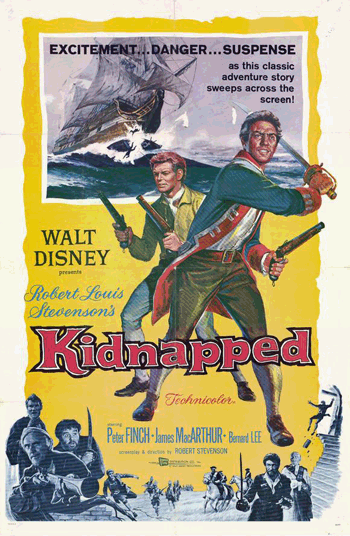 Directed by Disney stalwart Robert Stevenson, Kidnapped is a solid adaptation with handsome production values, including breathtaking location footage from Scotland, and an excellent cast including Peter Finch, Finlay Currie, and the film debut of Peter O’Toole.
Directed by Disney stalwart Robert Stevenson, Kidnapped is a solid adaptation with handsome production values, including breathtaking location footage from Scotland, and an excellent cast including Peter Finch, Finlay Currie, and the film debut of Peter O’Toole.
But sadly, even though the film was praised for its fidelity to the book and the excellence of its making, Kidnapped fared poorly at the box office. Many of the same critics who complained that Disney’s adaptation ofTreasure Island ten years before was too broad and flamboyant now complained that the adventure in Kidnapped was too tame and understated.
In his final role under his Disney contract, MacArthur was cast as the eldest son, Fritz, of the Swiss Family Robinson.
The idea for this film had actually come about during the location shooting of Third Man on the Mountain. Director Annakin and producer Walsh discussed Walt’s interest in what they felt was a rather creaky old warhorse, but once they found out that Walt was interested in a no-holds-barred adventure with little reliance on the original book, they both saw the potential for a spectacular and imaginative family epic, with elements of fantasy and fun that had become expected of anything that bore the Disney name.
As such, the performances of MacArthur and his talented co-stars (John Mills, Dorothy McGuire and Tommy Kirk) are frequently relegated to supporting status, passengers in a large, loud, fast-moving vehicle. There is little opportunity for outstanding acting, but all of the performers do well and create the characters necessary, even if they often are simply credible archetypes.
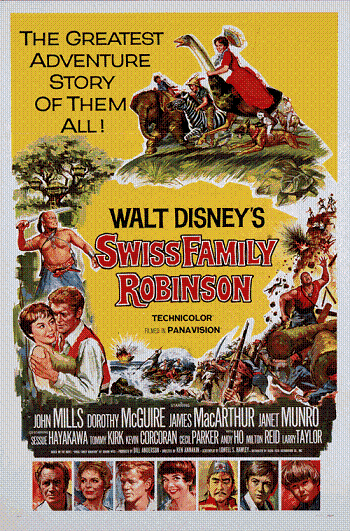 Although beset by production problems, delays, and a million dollar budget overrun, the final film was a huge hit with the public worldwide, and has since become one of the rare Disney live-action features to attain a “classic” status with generations of audiences.
Although beset by production problems, delays, and a million dollar budget overrun, the final film was a huge hit with the public worldwide, and has since become one of the rare Disney live-action features to attain a “classic” status with generations of audiences.
Looking back on these films, what is most unfortunate is that the body of work MacArthur did with Walt during his brief time under contract is not well known today. The first three films, perhaps, suffer from the fact that they are strong and serious dramas, without the elements of fantasy and humor that tend to be associated with Disney live-action films. (Walt himself was frustrated that his dramatic films were not more seriously regarded or widely successful. Once, after screening To Kill a Mockingbird, Walt remarked, “That’s the kind of film I’d like to make, but I can’t.”)
Although well received overall, none but Swiss Family Robinson achieved box-office success—and the resulting ritual conveyance by one generation of filmgoers to subsequent ones.
Sadly, even MacArthur himself was dismissive of his excellent early work with Walt, saying, “The parts I had in the four films I made for Walt Disney have all been good parts in their way. I mean none of them was a great acting role, but in very different ways they have all been extremely interesting.”
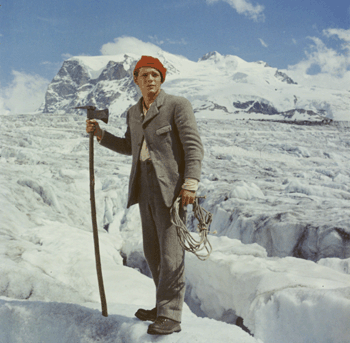 In this loss of legacy, the earnest and remarkable performances of a young James MacArthur are inexcusably forgotten—as is the primary connection of this fine actor with the visionary who saw such potential in his nascent talent, Walt Disney.
In this loss of legacy, the earnest and remarkable performances of a young James MacArthur are inexcusably forgotten—as is the primary connection of this fine actor with the visionary who saw such potential in his nascent talent, Walt Disney.
James MacArthur (1937-2010)
All photos courtesy of The Walt Disney Company.
